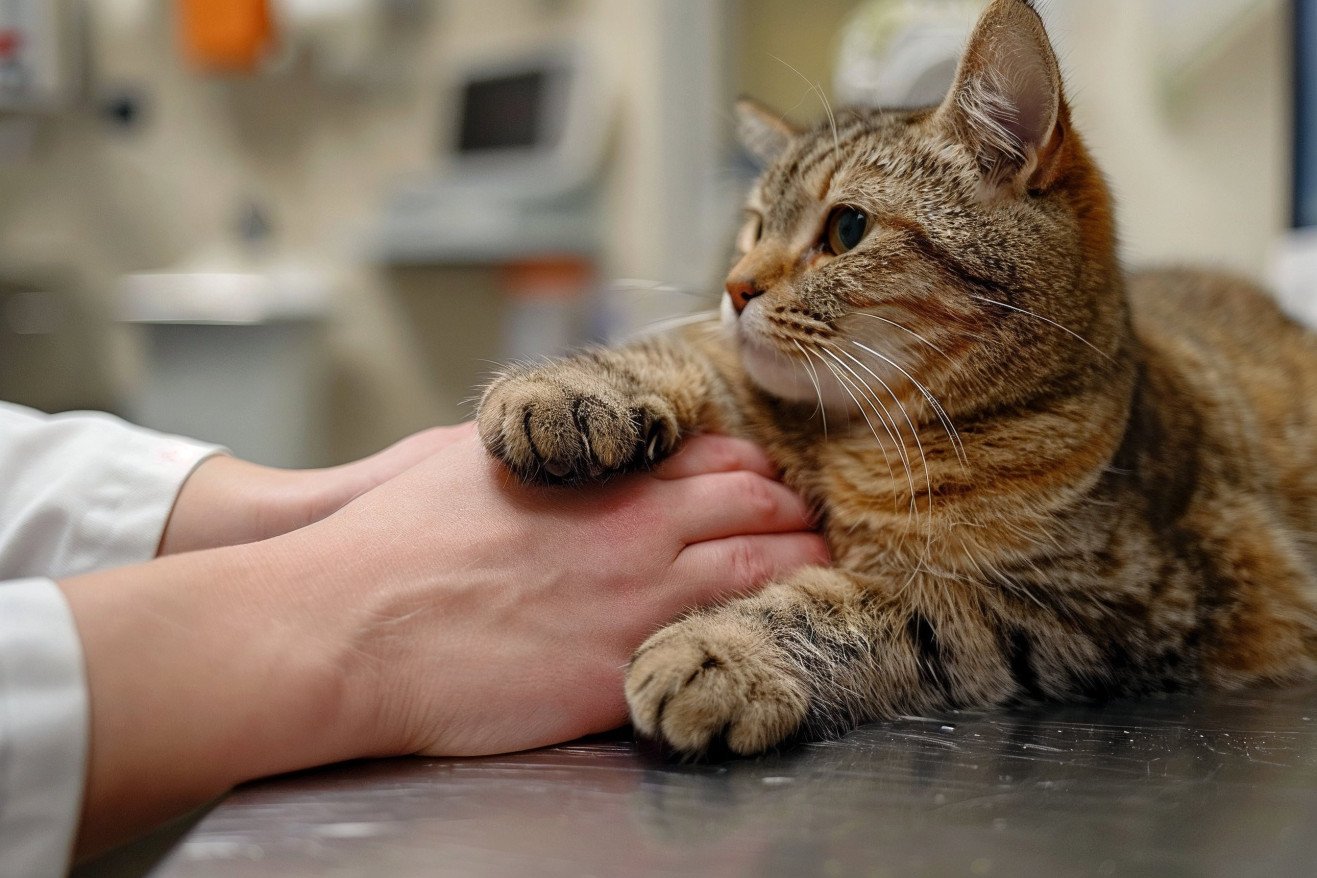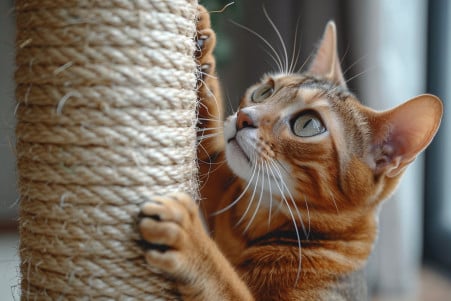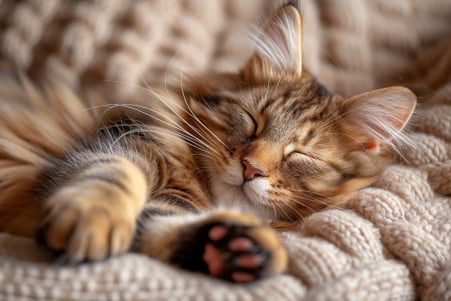Is Declawing Cats Bad? Exploring the Controversy
16 April 2024 • Updated 14 April 2024

The practice of declawing cats is controversial and has been the subject of much debate, especially since many experts have voiced concerns about the potential negative effects on a cat's physical and mental health. Although declawing may seem like a quick fix for furniture damage, the reality is that declawing—also known as onychectomy—involves the amputation of the third phalanx (toe bone) in a cat's paws, which can cause pain, limit a cat's ability to move, and even increase the likelihood of behavioral problems such as stress-induced or pain-induced biting.
We will explore the evidence-based scientific literature written by veterinary professionals, animal behaviorists, and major veterinary organizations that has thoroughly investigated the impact of declawing on a cat's well-being. By looking at the anatomy, potential complications, and the existence of alternative options, we hope to give you a comprehensive view that will help you decide whether or not to declaw your cat.
Is declawing cats bad?
The Research: Long-Term Effects of Declawing
The research on the long-term effects of declawing cats is alarming. A study published in the Journal of Feline Medicine and Surgery found that declawed cats were seven times more likely to have litter box issues, four times more likely to bite, three times more likely to be aggressive, and three times more likely to overgroom themselves excessively. Declawed cats were also three times more likely to suffer from back pain and chronic paw pain.
These results are consistent with data from the BC SPCA, which reports that 63% of declawed cats experienced abnormal bone growth and potential severe pain long-term where their toe bones were amputated. The American Veterinary Medical Association found that between 59-78% of declawed cats exhibited unwanted behavior changes like house soiling after the surgery.
While more research is needed on the psychological effects, the physical evidence suggests declawing can lead to significant loss of mobility and quality of life. Impaired walking, chronic pain, and the inability to scratch are all serious welfare concerns cited by veterinary professionals. Given the ongoing debate over declawing, it is important to look into alternative methods that can meet a cat's needs without impacting its welfare.
Humane Alternatives to Declawing
Instead of declawing, there are several humane alternatives that will allow cats to engage in their natural scratching behaviors without risking their health or quality of life. The American Veterinary Medical Association advises against declawing as an elective procedure and supports non-surgical alternatives, pointing out that scratching is a normal feline behavior.
One of the most important alternatives is to make sure that cats have access to appropriate surfaces for scratching. The Humane Society of the United States explains that cats prefer tall, sturdy scratching posts that are covered in materials like sisal rope or corrugated cardboard. If these posts are placed near the areas where the cat is already scratching, it can help redirect the behavior. The Just Cats Clinic also suggests using pheromone attractants like Feliscratch to encourage cats to scratch in approved areas.
If cats are still scratching inappropriately, Shallowford Animal Hospital recommends using deterrents like double-sided tape or plastic coverings on furniture. In addition, keeping a cat's nails trimmed and using nail caps can help reduce the damage caused by scratching. Positive reinforcement training and environmental enrichment are also important for redirecting scratching behavior, as noted by PAWS.
By addressing the root causes of destructive scratching with these humane alternatives, cat owners can ensure that their pets' needs are met without resorting to the extreme measure of declawing. As the practice of declawing becomes increasingly restricted, it's important to find ethical alternatives that will benefit the welfare of our feline friends.
The Legal Landscape: Declawing Bans and Restrictions
The increasing number of countries, states, and cities that have passed or are considering bans and restrictions on declawing is a positive indication of the rising awareness and concern for the welfare of cats. According to PETA, declawing is already illegal in many countries, including most of Europe, and in a number of U.S. states and cities.
In 2019, New York became the first state to pass a comprehensive ban on declawing, and Maryland followed suit in 2022. Senator Mike Brady notes that Massachusetts is currently considering a bill that would make it illegal to declaw cats unless it is medically necessary. Meanwhile, more than a dozen U.S. cities, including several in California, have also banned the procedure.
Internationally, Alley Cat Allies says that at least 42 countries have outlawed declawing, with Canada being the most successful at the national level, where declawing is illegal in most of its provinces. These bans and restrictions reflect the growing consensus that declawing is a form of abuse and an unnecessary amputation that harms the welfare of cats.
As the legal tide turns against declawing, the future of the controversial procedure is uncertain. However, veterinarians and animal welfare groups will be instrumental in pushing for and enacting humane policies that prioritize the health and well-being of cats.
Veterinary Perspectives: Ethical Considerations and Best Practices
Leading veterinary organizations, such as the American Veterinary Medical Association (AVMA) and the American Association of Feline Practitioners (AAFP), have come out strongly against declawing as an elective procedure. The AVMA discourages declawing and instead supports non-surgical alternatives, explaining that "declawing is a major surgery involving amputation and is not medically necessary for the cat in most cases."
The AAFP strongly opposes declawing, pointing to the "inherent risks and complications" such as acute pain, infection, nerve trauma, lameness, behavioral problems, and chronic pain. They state that declawing should only be considered if it is the only way to prevent euthanasia and all other humane options have been exhausted.
Meanwhile, the ASPCA observes that laws prohibiting declawing can be problematic because there may be rare circumstances where the procedure is warranted. They suggest that veterinarians should be sure to fully inform pet owners about the risks and only perform declawing if all other options have been attempted.
In the end, the veterinary community stresses the ethical obligation to put a cat's welfare first and look for humane alternatives before turning to declawing. By partnering with pet parents to address the causes of scratching, vets can help ensure that cats receive the care they need in a way that is compassionate.
Conclusion: Taking a Compassionate Approach to Cat Ownership
The practice of declawing cats is controversial and ethically fraught and should be undertaken with extreme caution. The procedure, also known as onychectomy, involves the amputation of the cat's third toe bone, a major surgery that can have serious and long-term consequences for the cat's physical and psychological well-being.
Studies have shown that declawed cats are more likely to suffer from chronic pain, bone spurs, lameness, litter box issues, and increased aggression or biting. A study in the Journal of Feline Medicine and Surgery even found that declawed cats were up to seven times more likely to experience these problems than non-declawed cats.
Instead of declawing, experts recommend a number of humane alternatives that will allow cats to fulfill their natural scratching instincts without putting their health at risk. These alternatives include providing scratching posts, using nail caps, and training cats with positive reinforcement. The American Veterinary Medical Association goes so far as to say that declawing should not be considered an elective procedure and should only be done as a last resort.
The legal tide has also turned against declawing, with several countries, states, and cities banning or restricting the practice. According to PETA, declawing is now illegal in most of Europe, as well as the U.S. states of New York and Maryland. This trend shows that more and more people are recognizing that declawing is an unethical and inhumane practice that is detrimental to a cat's well-being.
As cat owners, it's up to us to put our feline friends' well-being first. By considering alternatives and making choices that take a cat's natural instincts into account, we can ensure that we're providing our pets with the best care and consideration.


